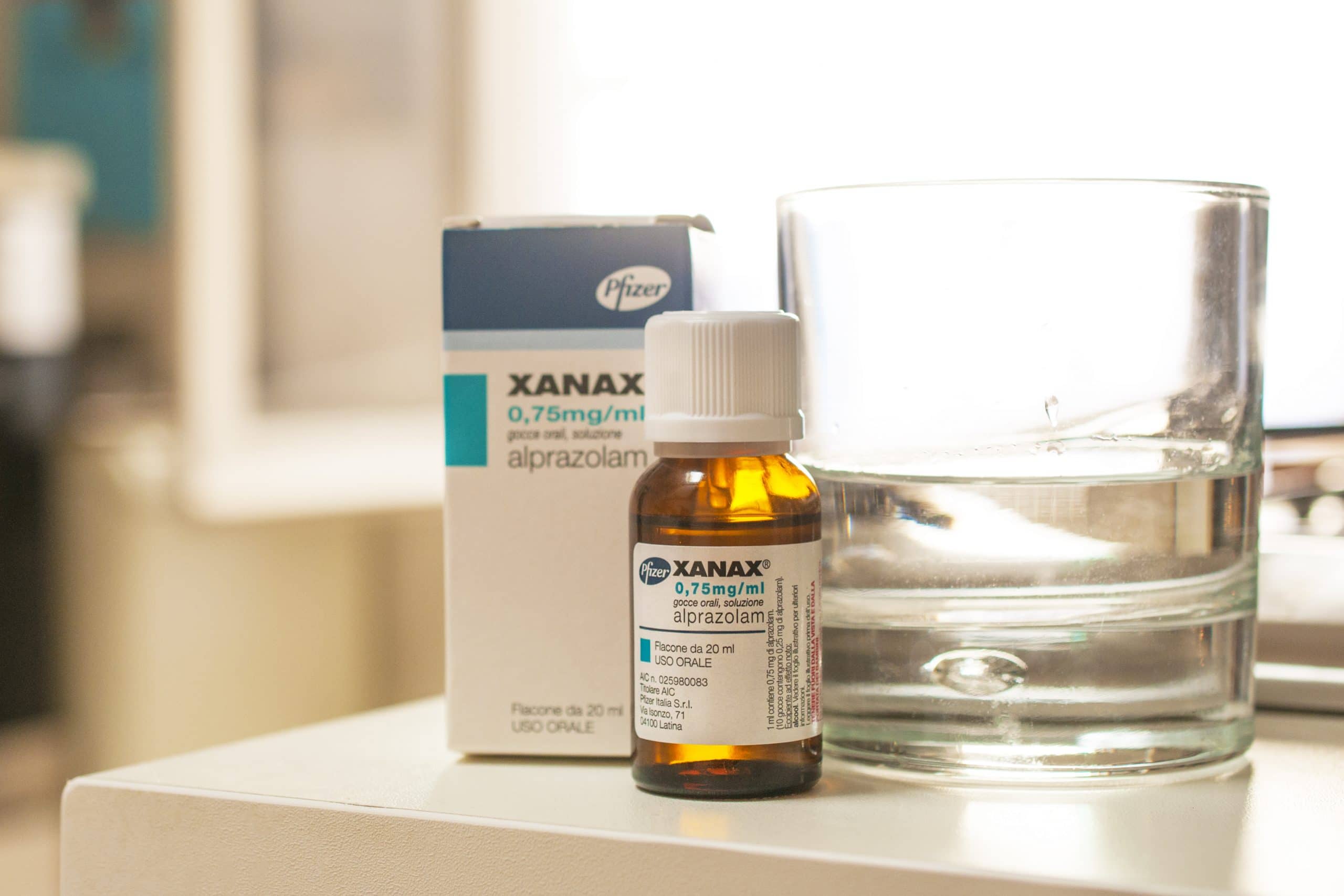
Benzodiazepines, referred to as benzos, are a type of prescription tranquilizer. Two common benzodiazepines are Xanax and Valium. Even though benzos are prescribed because of their calming effects, a person who abuses them can become addicted.
The abuse of benzos can lead to physical, behavioral, and psychological symptoms. Over time people who abuse benzodiazepines will build up a tolerance and will need to take more to feel the same effects. When the body builds a tolerance to benzodiazepines, the person has become addicted.
Once a person cuts down on the amount they take or stops taking benzos altogether, this leads to withdrawal symptoms. The withdrawal symptoms from benzodiazepines can be dangerous and can be so uncomfortable that it quickly leads to relapse. A medical detox program and continuing into inpatient treatment is the best chance at recovery from benzodiazepine addiction.
What Are Benzodiazepines?
The National Institute on Drug Abuse states that benzodiazepines cause a shift in the brain’s chemical signals to communicate pleasure. This change makes people feel joy and security. The continued use of benzos makes the brain believe the effects of benzos are normal.
Common types of benzos are:
- Xanax (Alprazolam): Used to treat anxiety and panic disorders. Extended-release Xanax is extremely dangerous when crushed because a person gets the dose all at once. Because of this, Xanax is the most hazardous benzo.
- Klonopin (Clonazepam): Treats seizure and panic disorders. Klonopin is intermediate-acting benzo that dissolves in the mouth.
- Valium (diazepam): Prescribed to treat anxiety, alcohol withdrawal, and muscle spasms. Valium is the oldest benzo on the market and takes a while to take effect. Valium is not an instant gratification drug and is not often the first choice in benzo abuse.
- Ativan (Lorazepam): Prescribed for individuals with a panic disorder. Ativan comes in pill and liquid form. This makes it easy to inject, delivering an immediate reward.
- Ambien (Zolpidem): A hypnotic drug used to help people sleep through the night. Ambien makes people fall asleep quickly but has adverse effects. Individuals who use Ambien can do things in their sleep, such as cooking and even driving. Still, the user will not remember any of it. Ambien is not often abused because the user normally falls asleep before they can take another dose.
Over time, the altered brain cells will not be able to function without benzos. Without the usual dose of benzos, a person will start to experience cravings. Cravings are the brain’s way of getting your attention. Cravings that are not fulfilled will lead to withdrawal symptoms.
Even though benzodiazepines are legally prescribed medication, their misuse can have detrimental side effects. The following are statistics about benzodiazepine abuse and its risks.
- Most benzo addiction starts with a therapeutic prescription for benzos.
- The top four benzodiazepines prescribed in the US are Ativan, Xanax, Klonopin, and Valium.
- The most common demographic to abuse benzos are males between the ages of 18 and 34.
- 95% of individuals who seek treatment for benzo abuse also have an addiction to another substance.
- 82% of individuals seeking treatment for benzos have a primary addiction other than benzos.
- In 2017 11,000 deaths were associated with benzodiazepine use in the United States.
What Is Benzodiazepine Addiction?
Benzodiazepines work by suppressing the central nervous system. Using benzodiazepines causes a sedated effect and a feeling of relaxation. The use of benzos over a long period of time changes the way a person’s brain functions.
It can lead to decreased responsiveness to benzodiazepines. When a person needs more of the drug to feel the same effects as in the beginning, the body has built up a tolerance to benzodiazepines.
Once a person has built a tolerance to benzos, the psychological dependence begins and, if not treated, leads to addiction. In the beginning, a person may be able to hide their use of benzodiazepines. Still, the signs and symptoms of use soon start to appear.
Signs and symptoms of benzodiazepines include:
- Anxiety
- Depression
- Excessive sweating
- Insomnia
- Hand tremors
- Seizures
- Hallucinations
The term “hypnotic, sedative, or anxiolytic use disorder” is used to describe benzodiazepines’ abuse. For a person to be diagnosed with hypnotic, sedative, or anxiolytic use disorder, they must meet at least two of the eleven symptoms within a 12-month period. The National Association of Addiction explains each symptom. Five of the eleven traits are as follows.
- A sedative is taking a higher dose than prescribed and taking longer than prescribed.
- A significant amount of time is spent obtaining, using, and recovering from sedative use.
- Without the drug, a person experiences withdrawal symptoms, including cravings.
- A person has built-up tolerance.
- The use of sedatives affects work, school, or home life.
The sedative effects and addiction-forming chemical properties can lead to abusing benzodiazepines. Many people have prescribed benzos for medical reasons, but that can quickly lead to abuse. If a person runs out of their prescription, it can lead to doctor shopping or buying benzos off the street.
Symptoms Of Benzodiazepine Addiction
The physical and psychological signs reveal the dangers of abusing benzodiazepines. Every person reacts differently to benzos, and mild symptoms can quickly become life-threatening. The symptoms of benzodiazepines include:
- Muscle weakness
- Slurred speech
- Confusion
- Making poor decisions
- Blurred vision
- Impaired motor skills
- Dizziness
- Coma
- Trouble breathing
- Overdose or even death
The chronic abuse of benzodiazepines can lead to:
- Memory problems
- Headaches
- Anxiety
- Tremors
- Insomnia
- Anorexia
Physical dependence is a medical condition of the development of tolerance to benzodiazepines. As discussed, tolerance is the process in which the brain becomes accustomed to the presence of benzos. As the brain adjusts to the level of benzodiazepines in a person’s body, it requires more to feel the original high.
If a person cuts down or stops taking benzos, the brain goes into “shock” and withdrawal symptoms begin. The risk of uncontrollable seizures is prominent. It is particularly dangerous for individuals to withdraw from benzodiazepines. It is highly recommended to attend a medical detox program to safely withdraw.
It is crucial to recognize the signs and symptoms of benzodiazepine abuse and overdose. When a person overdoses on benzos, it is life-threatening and requires medical intervention. Ideally, the person who uses benzodiazepines will be honest about what they have taken and how much they took, but that is not always the case. So with the first sign of overdose, it is vital to get emergency help.
Behavioral Signs Of Benzodiazepine Addiction
Individuals may not realize that sedative use disorder is slowly developing. But when it develops, it can be impossible to hide. When a person is abusing benzodiazepines, they start to exhibit uncharacteristic behaviors. According to the Mayo Clinic, a person abusing benzodiazepines will exhibit specific actions, including the following.
- Individuals will isolate and withdraw from friends and family.
- People will hoard benzos in fear of running out.
- People will do anything for benzodiazepines such as borrowing money, stealing, and max out credit cards.
- People will engage in risky behaviors to achieve drugs and when they are high. These behaviors can include driving while high, entering dangerous areas to buy benzos, and may even prostitute themselves for drugs and money.
- A decrease in personal hygiene can happen in a person fighting benzodiazepine abuse.
- A person on benzos will become highly secretive and also lie about what they are doing.
- People who once were happy-go-lucky and loved being around friends and family are now irritable, rude, and have a new set of friends.
People who abuse benzodiazepines usually swallow pills. Crushing benzos does not seem to have a different effect, and benzos are not injectable, so there isn’t paraphernalia lying around. For this reason, it is easier to abuse benzos around other people and not be noticed.
“Doctor shopping” is prevalent in people who abuse benzodiazepines. Individuals will visit a few different doctors and get a prescription for a benzodiazepine. Then they visit a few different pharmacies to get them filled. A sign of “doctor shopping” is when a person has multiple bottles of the same drug from different doctors and pharmacies.
Treatment For Benzodiazepine Addiction
Approximately one-third of those who abuse benzodiazepines for six months or more will experience withdrawal symptoms, including seizures. Addiction treatment for benzos such as Ativan, Ambien, Klonopin, Xanax, and Valium must begin with a medical detox program. The symptoms of withdrawal from benzodiazepines can be dangerous and even life-threatening.
The 24-hour supervision of a medical detox program is the safest way for individuals to start their recovery. A medical detox program can manage the symptoms of benzodiazepine withdrawal with medications and psychological support. The symptoms of benzo withdrawal can be mild to severe and include:
- Sleep disturbances
- Anxiety
- Panic attacks
- Increased tension
- Difficulty concentrating
- Headaches
- Heart palpitations
- Excessive sweating
- Muscle spasms and discomfort
- Hand tremors
- Seizures
- Changes in perception
- Hallucinations
- Psychosis
- Increased suicidal thoughts and behaviors
The duration of withdrawal from benzos depends on the type, amount, and any co-occurring disorders. The first signs of withdrawal can start within a few hours, while some symptoms may persist for months or years. Starting a recovery journey in a medically supervised detox program makes it easier to transition into an inpatient treatment program.
Inpatient Treatment For Benzo Abuse
It is not enough to just go to a medical detox program for benzo abuse. A person needs to continue treatment in an inpatient setting. Inpatient addiction treatment offers the highest chance at a successful recovery. Relapse is a high possibility of a person leaves detox and goes back into their normal life.
Medical detox programs only focus on safely rid your body of benzos and making individuals as comfortable as possible. Once a person enters inpatient treatment, a full recovery plan is designed, and the second phase of treatment can begin. Individualized treatment plans include a combination of individual therapy, group therapy, and multiple forms of alternative therapies.
Individual therapy
Individual therapy is one-on-one with a therapist. In individual therapy, a person will dive into the deep-rooted issues that lead to addiction and learn healthy coping skills.
Group therapy
Group therapy is a vital part of the recovery process. In group therapy, individuals share their experiences and learn from other’s experiences. Groups meet multiple times a day and discuss different topics regarding addiction. Group therapy helps build reliable support systems to lean on when the recovery road gets difficult.
Family therapy
Family therapy is essential to rebuilding relationships that addiction to benzos destroyed. Therapists will help families heal the childhood trauma that led to addiction. Families receive education on benzodiazepine addiction and how to support their loved ones through recovery and beyond.
Cognitive-Behavioral Therapy (CBT)
CBT provides individuals with tools to cope with their addiction. People learn to recognize the behaviors surrounding their addiction and how to turn them into healthy, positive behaviors. Cognitive-behavioral therapy is beneficial in treating co-occurring mental health disorders.
Dialectical Behavioral Therapy (DBT)
Dialectical Behavioral Therapy is a type of cognitive-behavioral therapy. DBT addresses an array of behavioral disorders. In dialectal therapy, therapists evaluate the thought process and develop the best method to change the thoughts and behaviors that result from benzo abuse.
In combination with medication management, the above therapies give the best chance of healing the complete person and having a successful addiction recovery. Though people have tried to beat their addiction to benzodiazepines in an outpatient program, the triggers and stressors in life tend to lead to relapse.
Continued Care For Benzodiazepine Addiction
An addiction to benzos does not just disappear after treatment is over. Some people go to 12-step meetings for the rest of their life to avoid relapse and to help others struggling to stay sober. Before leaving a treatment program, therapists will sit down with individuals and write out how to handle any situation that may arise when you re-enter society.
Relapse prevention plans also entail goals a person has set for themselves. Having all of this in writing to look at every day can help keep a person on track with their sobriety and their life goals. If a person is at risk of relapse, the individualized relapse prevention plan will have a list of numbers to call to help individuals through the cravings.
Benzodiazepine Addiction Treatment at Granite Mountain Behavioral Healthcare
At Granite Mountain behavioral health, we not only treat addiction. We offer specialized treatment for those with co-occurring mental health disorders. Our philosophy is “Transforming the MIND, BODY, & SPIRIT… through the community, commitment, and connection.”
If you or a loved one is battling an addiction to benzodiazepines and co-occurring health disorders, we can help you. Give us a call, and we can answer all your questions.
References:
https://www.semel.ucla.edu/dual-diagnosis-program/Conditions_Treated/Benzodiazepine_Addictions
https://www.uclahealth.org/Resnick/benzodiazepine-addiction


